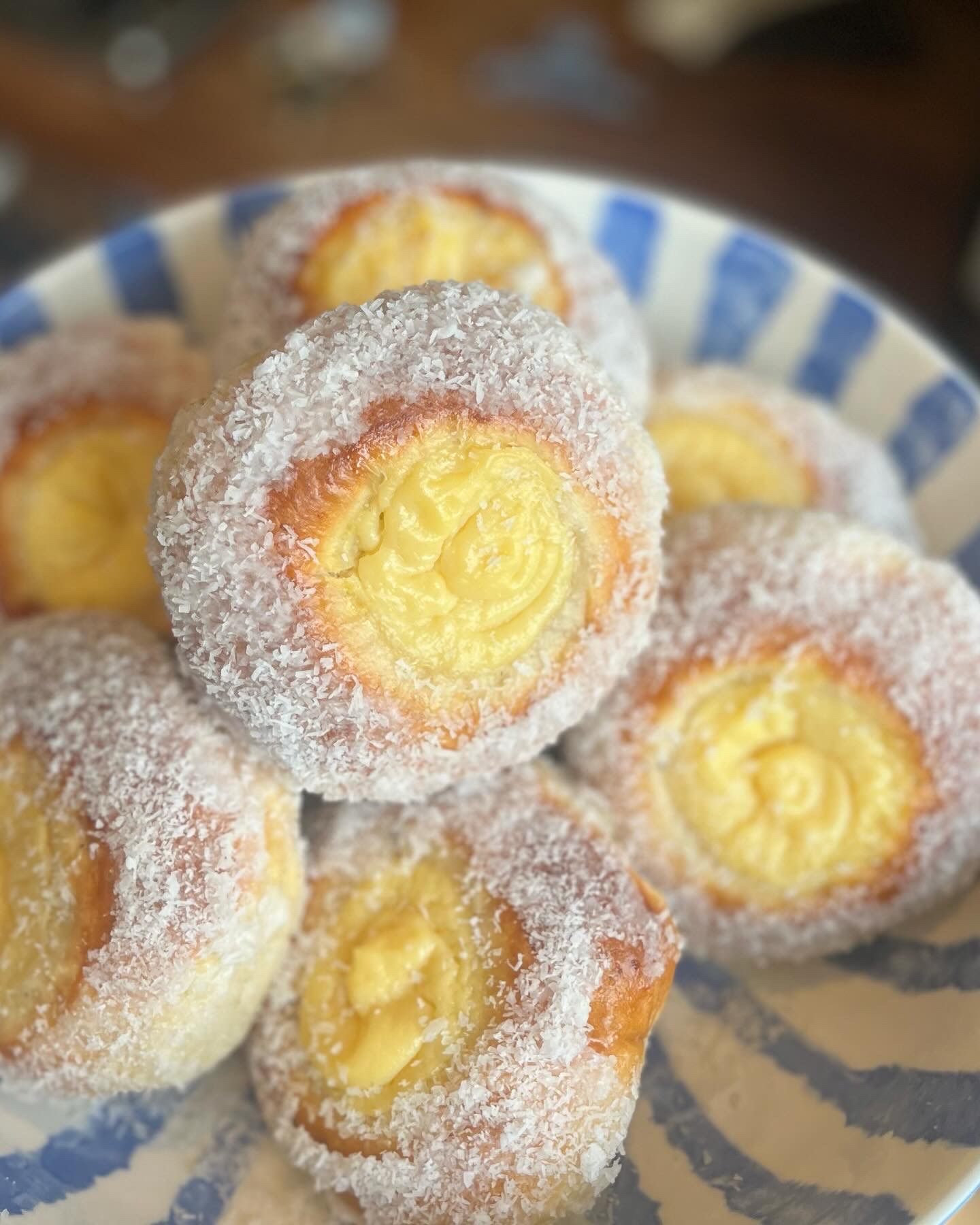NORWEGIAN SCHOOL BUNS ("SKOLEBOLLER")
- Martine Hornseth
- Jun 29
- 2 min read
Updated: Jul 2

Norwegian skoleboller, also known as school buns, are a beloved sweet treat in Norway—pillowy soft cardamom buns filled with creamy vanilla custard, topped with a dusting of coconut and a drizzle of icing. Whether you're looking to recreate a taste of Scandinavia or explore a new baking tradition, mastering the ingredients is key to getting that truly authentic flavor and texture.
The Right Flour: Why Plain White Flour Is Best
For the soft, fluffy texture that skoleboller are famous for, plain white flour (all-purpose flour) is the ideal choice. It provides just the right amount of gluten structure without making the dough tough or chewy.
Fresh Yeast vs. Instant Yeast: What’s the Difference?
Both instant yeast and fresh yeast can be used in skoleboller, but for traditional Norwegian baking, fresh yeast is often preferred. Fresh yeast also tends to perform better in enriched doughs (those with sugar, butter, and milk), which can slow yeast activity. Fresh yeast is more forgiving and can handle these ingredients better than instant yeast.
Norwegian Vanilla Sugar: A Sweet Secret
A defining flavor in the custard filling of skoleboller comes from Norwegian vanilla sugar—a fine sugar infused with real vanilla. Unlike vanilla extract or vanilla essence, vanilla sugar adds both sweetness and depth of flavor without altering the custard’s texture.
Cardamom: Norway’s Favorite Spice
No skoleboller recipe is complete without cardamom, a spice deeply rooted in Norwegian baking traditions. With its warm, citrusy notes, ground cardamom adds a signature aroma and flavor to the dough. It pairs beautifully with the custard and coconut, making each bite uniquely Nordic.
How to Make Soft Cardamom Dough by Hand
Making yeast dough by hand is deeply satisfying and gives you better control over texture and hydration. Here’s how to get it right:
Warm (not hot) milk: Make sure the milk is warm to the touch (around 37–40°C / 98–104°F) to activate the yeast without killing it.
Dissolve fresh yeast properly: Crumble the fresh yeast into the warm liquid and stir until fully dissolved. Let it sit for 5–10 minutes until slightly frothy if unsure about activity.
Mix gradually: Add the dry ingredients gradually while stirring with a wooden spoon or your hand. This helps you gauge how much flour is needed—too much, and the dough becomes dry.
Knead with rhythm: Knead for 10–12 minutes until the dough is smooth, elastic, and slightly tacky but not sticky.
First rise matters: Let the dough rise in a warm place until doubled in size—usually about 60–90 minutes. Cover with a clean towel or plastic wrap to retain moisture.
Pro Tip: Use freshly ground cardamom if possible. It’s more aromatic than pre-ground.
Making the Perfect Vanilla Custard (Krem)
The luscious custard center is what makes skoleboller really special. Here’s a few tips:
Heat gently: Cook over medium heat, whisking constantly. Once it begins to thicken, reduce the heat slightly to avoid scrambling the eggs.
Remove when thickened: Once the custard reaches a pudding-like consistency, take it off the heat to avoid the custard being too thick.
Cool before using: Transfer to a bowl, cover with plastic wrap (touching the surface to prevent a skin), and let it cool fully before piping into the buns.
Notes



1
To make the dough, gently heat the milk until lukewarm - not hot. Stir in the yeast until dissolved.



2
In a large bowl or stand mixer, add sugar, ground cardamom, vanilla, and about two-thirds of the flour to the warm milk and yeast.



3
Mix the dough by hand or with a dough hook, gradually adding the remaining flour until a soft, slightly sticky dough forms. Knead until the dough begins to pull away from the sides of the bowl.



4
Add the softened butter and knead for about 10 minutes, until the dough becomes smooth and elastic.



5
Cover with a towel or plastic wrap and let the dough rise in a warm place for about 1 hour, or until doubled in size.



6
For the Vanilla Custard, heat the milk with half the sugar in a saucepan and add the vanilla sugar (or essence), stirring occassionally.



7
In a bowl, whisk the remaining sugar with cornstarch. Add the egg yolks and whisk until smooth and pale.



8
When the milk begins to bubble, slowly pour half into the egg mixture while whisking constantly.



9
Return the tempered mixture to the saucepan. Cook over medium heat for about 2 minutes, whisking constantly, until thickened.



10
Remove from heat and transfer to a clean bowl. Cover with plastic wrap pressed directly onto the surface and let cool completely.



11
To shape the dough, once risen, turn the dough out onto a lightly floured surface. Roll into a long log and cut into 12 equal pieces. Shape each piece into a smooth ball.



12
Place dough balls on parchment-lined baking sheets. Press a deep well into the center of each using your fingers, the back of a spoon, or an egg cup.



13
Transfer the vanilla custard from the bowl into a piping bag (or a zip-lock bag with a 1.5cm hole cut from a corner). Pipe about 1–2 tablespoons of custard into each well. Cover loosely and let rise again for 30 minutes.



14
Preheat oven to 210°C (410°F ). Whisk the egg (add milk if desired) and brush over the dough. Bake for 10–14 minutes, or until golden brown.



15
Prepare the topping whilst the buns are cooking. In a medium sized shallow bowl, mix the icing sugar and water until you reach a thick, spreadable consistency. Then spread the desiccated coconut in a separate, shallow bowl.



16
Remove the buns from the oven, they should be golden brown and spring back slowly when you poke them. Leave the buns to fully cool.



17
Once the buns are fully cooled, spread icing around the custard centers (I like to put the icing sugar mix in a wide bowl, and dip the edges of the custard filled buns by holding them upside down). Press each bun, icing-side down, into the coconut to coat the edges.



18
Skoleboller are best served fresh, but can be stored in an airtight container for up to 3 days, or frozen for up to 3 months. To get the newly baked feeling again, heat the frozen buns in the oven at 150 degrees Celsius for 10-15 minutes.
Instructions
1.5 cups Milk
4 teaspoons Instant Yeast (or 50g Fresh Yeast)
0.5 cups Sugar
2 teaspoons Ground Cardemom
1 teaspoon Vanilla Sugar (or Extract)
5 cups Flour
7 tablespoons Softened Butter
Cardemon Dough
1.25 cups Milk
1/3 cup Sugar
3 Egg Yolks
2 tablespoons Cornflour (Cornstarch)
2 teaspoons Vanilla Sugar (or Extract)
Vanilla Custard
1 Egg
1.75 cups Icing Sugar (Confectionary)
3 tablespoons Water
1 cup Desiccated Coconut
Coconut Topping

NORWEGIAN SCHOOL BUNS ("SKOLEBOLLER")

Cardemom buns with a sweet and creamy vanilla custard in the middle, and a desicated coconut topping.
Servings :
12
Calories:
Prep Time
30 minutes
Cooking Time
30 minutes
Rising Time
1 hour 30 minutes
Total Time
2 hours 30 minutes



コメント